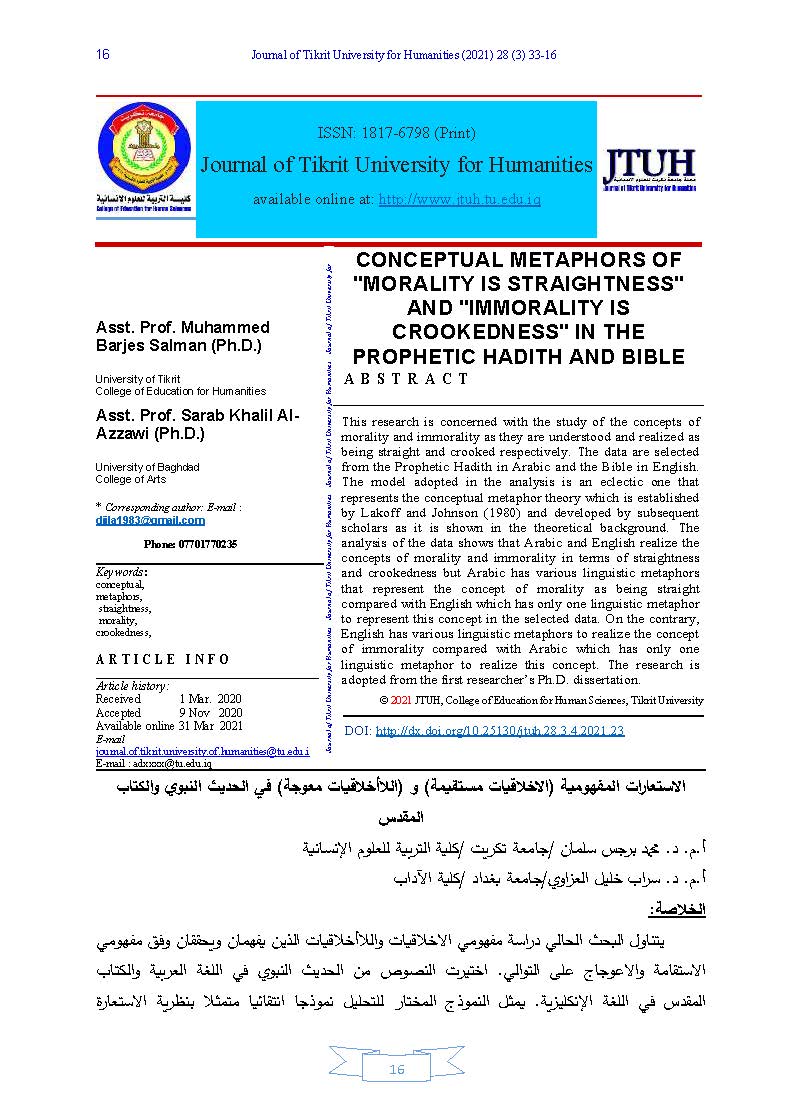الاستعارات المفهومية (الاخلاقيات مستقيمة) و (اللاأخلاقيات معوجة) في الحديث النبوي والكتاب المقدس
محتوى المقالة الرئيسي
الملخص
يتناول البحث الحالي دراسة مفهومي الاخلاقيات واللاأخلاقيات الذين يفهمان ويحققان وفق مفهومي الاستقامة والاعوجاج على التوالي. اختيرت النصوص من الحديث النبوي في اللغة العربية والكتاب المقدس في اللغة الإنكليزية. يمثل النموذج المختار للتحليل نموذجا انتقائيا متمثلا بنظرية الاستعارة المفهومية التي بدأت بنشر ليكوف وجونسن لكتابهما في العام (1980) وما تلاه من تطور للنظرية من قبل المختصين لاحقا والذي سيتم بيانه في لجانب النظري من البحث. بين التحليل للنصوص المختارة ان مفهومي الاخلاقيات و اللاأخلاقيات تم التعبير عنهما بالاستقامة والاعوجاج على التوالي الا ان العربية عبرت عن الاستقامة باستعارات لغوية متنوعة مقارنة مع الإنكليزية التي عبرت عنها باستعارة لغوية واحدة. على النقيض، تمتلك الإنكليزية استعارات لغوية متنوعة للتعبير عن اللاأخلاقيات مقارنة مع الغربية التي لم تستخدم الا استعارة لغوية واحدة للتعبير عن هذا المفهوم. البحث مأخوذ من أطروحة الدكتوراه للباحث الأول.
المقاييس
تفاصيل المقالة

هذا العمل مرخص بموجب Creative Commons Attribution 4.0 International License.
College of Education for Humanities, TIKRIT UNIVERSITY. THIS IS AN OPEN ACCESS ARTICLE UNDER THE CC BY LICENSE http://creativecommons.org/licenses/by/4.0/
المراجع
Al-Bukhāri, M. I. (d256AH) (2007). Šaĥīh ul-Bukhāri. Translated into English by: Al-Sharif, M. M. Beirut: Dar Al-Kotob Al-Ilmiyah.
An-Naisābūri, Muslim (d261AH) (2012). Šaĥīĥ Muslim. Beirut: Dar Al-Kotob Al-Ilmiyah.
An-Nawawi, Y. (2004). Riyadh uš-Šaliheen min Kalami Saiyd il-Mursaleen. Cairo: Maktabat uš-Šafa.
At-Tabrīzi, M. A. (2002). Mishkāt ul-Mašābīĥ. Translated into English by: Al-Sharif, M. M. Beirut: Dar Al-Kotob Al-Ilmiyah.
Clarke, Adam (1832). The Adam Clarke Commentary. Retrieved from: http://www.studylight.org/commentaries/acc/
Coffman, James (1999). Commentaries on the Old and New Testaments. Retrieved from: http://www.studylight.org/commentaries/bcc
Coke, Thomas (1803). Commentary on the Holy Bible. Retrieved from: http://www.studylight.org/commentaries/tcc/
Deignan, Alice (2005). Metaphor and Corpus Linguistics. Amsterdam: John Benjamin's Publishing Company.
Geeraerts, Dirk (2010). Theories of Lexical Semantics. Oxford: Oxford University Press.
Gill, John (1999). The New John Gill Exposition of the Entire Bible. Retrieved from: http://www.studylight.org/commentaries/geb/
Johnson, Mark (1987). The Body in the Mind: The Bodily Basis of Meaning, Imagination, and Reason. Chicago: The University of Chicago Press.
Kövecses, Zoltan (2002). Metaphor: A Practical Introduction. Oxford: Oxford University Press.
Kretzmann, Paul (1923). Popular Commentary of the Bible. Retrieved from: http://www.studylight.org/commentaries/kpc
Lakoff, George and Johnson, Mark (1980a) Metaphors We Live By. Chicago: The University of Chicago Press.
Lakoff, George and Johnson, Mark (2003) Metaphors We Live By with a New Afterward. Chicago: The University of Chicago Press.
Lakoff, George ; Espenson, J. and Schwartz, A. (1991). Master Metaphor List. California: Cognitive Linguistics Group.
Merriam-Webster's Collegiate Dictionary (11th Edition). (2004). Massachusetts: Merriam-Webster, Incorporated.
Oxford: Advanced Learner's Dictionary of Current English. (2000). Hornby A. S. (6th Edition). Edited by: Sally Wehmeier. Oxford: Oxford University Press.
Pragglejaz Group (2007). "MIP: A Method for Identifying Metaphorically Used Words in Discourse" in Metaphor and Symbol (vol22). Amsterdam: Lawrence Erlbaum Association, Inc. p.p. 1-39.
SOED The Shorter Oxford English Dictionary (2002). Oxford: Oxford University Press. (CD-ROM, version 2.00).
Stockwell, Peter (2002). Cognitive Poetics: An Introduction. London: Routledge.
Ungerer, Friedrich and Schmid, H. (2006). An Introduction to Cognitive Linguistics. London: Longman.




